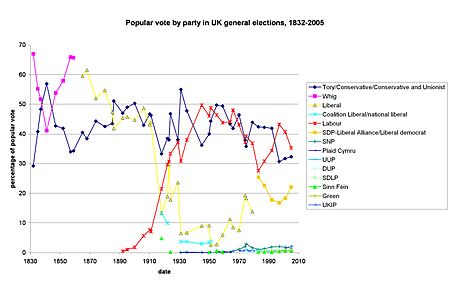History of the Labour Party (UK) facts for kids
The British Labour Party is one of the two main political parties in the United Kingdom. It began in the late 1800s. It grew out of the trade union movement, which worked to improve conditions for working people. By the early 1920s, Labour had become the main rival to the Conservative Party, taking the place of the Liberal Party.
In the 1930s and 1940s, Labour focused on national planning. This included taking important industries into public ownership, which is called nationalisation. This idea was part of their original rules, known as Clause IV. This rule said that important industries and services should be owned and controlled by everyone. This rule was later changed in 1994.
Contents
Labour in Government: Key Moments
The Labour Party has been in charge of the government several times.
Early Governments
- First Prime Ministers: The first time Labour formed a government was in 1924, with Ramsay MacDonald as Prime Minister. They were a minority government, meaning they didn't have enough Members of Parliament (MPs) to pass laws easily without help from other parties. MacDonald led another minority government from 1929 to 1931. Later, he and some of his ministers left the main Labour Party.
- World War II: During World War II, from 1940 to 1945, Labour was a junior partner in a special government that included all major parties.
Building the Welfare State
- After World War II: After the war, in the 1945 election, Labour won a huge victory under Clement Attlee. His government (1945–1951) created the welfare state. This included setting up the National Health Service (NHS), which provides free healthcare for everyone. They also took about a fifth of the country's economy into public ownership. During this time, the UK also joined NATO and stood against the Soviet Union in the Cold War.
Modernising Britain
- The 1960s and 1970s: Labour was in government again from 1964 to 1970 under Harold Wilson. His government focused on making the economy more modern. Wilson returned as Prime Minister from 1974 to 1976, and then James Callaghan took over until 1979.
- Tough Times: The late 1970s were a difficult time for the economy, known as the "Winter of Discontent". There were also disagreements within the party, and some members, like David Owen, left to form a new party. This led to Labour being out of power during the 1980s and early 1990s, when the Conservative Party was in charge.
Return to Power and Recent Years
- New Labour Era: Labour won a massive victory in the 1997 election with Tony Blair as leader. They had a very large number of MPs. Their majority was slightly smaller in the 2001 election and then reduced more in the 2005 election.
- Recent Elections: Gordon Brown became Prime Minister in 2007. Labour lost the 2010 election and became the main opposition party. After more losses in the 2015 election, Ed Miliband resigned as leader. Labour remained in opposition after the 2017 election and lost again in the 2019 election, which led to the end of Jeremy Corbyn's time as leader. The party is currently led by Keir Starmer.
Images for kids
-
Keir Hardie, one of the Labour Party's founders and its first leader
-
Ramsay MacDonald, the first Labour Prime Minister, 1924, 1929–35 (National from 1931 to 1935)
-
Clement Attlee, Labour Prime Minister (1945–51)
-
Harold Wilson, Labour Prime Minister (1964–70 and 1974–76)
-
James Callaghan, Labour Prime Minister (1976–79)
-
Michael Foot, leader of the party in opposition (1980–83)
-
Neil Kinnock, leader of the party in opposition (1983–92)
-
Gordon Brown, Labour Prime Minister (2007–2010)
-
Ed Miliband, leader of the party in opposition (2010–2015)
-
Jeremy Corbyn, leader of the party in opposition (2015–2020)
-
Keir Starmer, leader of the party in opposition (2020–present)
See also
- History of the Conservative Party (UK)
- History of trade unions in the United Kingdom
- Liberal Democrats (UK) § History
















